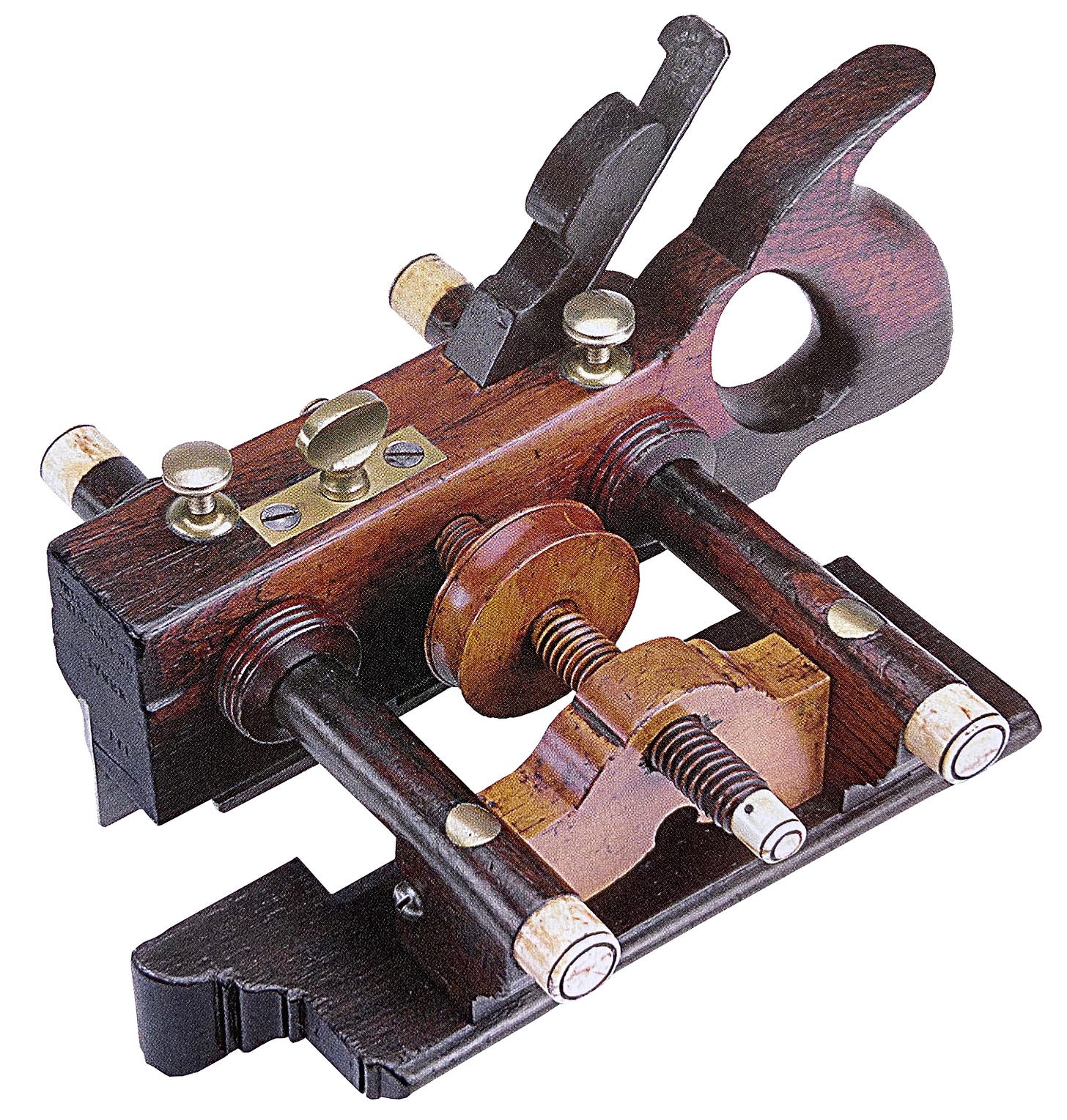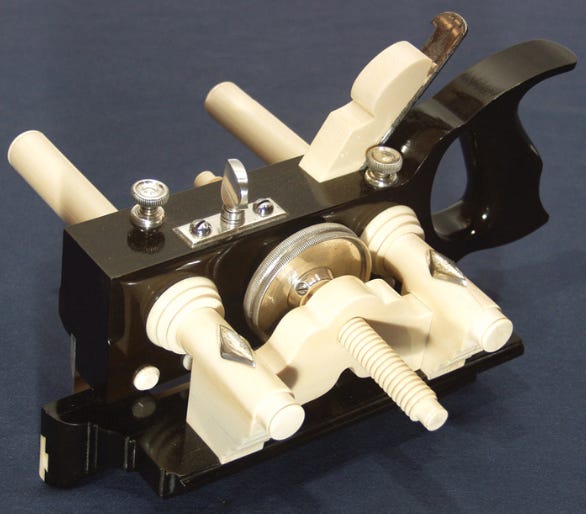Wooden Plow Planes A Celebration of Planemakers Art By Don Rosebrook Dennis Fisher
The screw arm plow airplane is one of the nigh iconic wooden planes. They're beautiful, the fever dream of a hyperactive woodworker. "How is it," asks collector Don Rosebrook," that such a simple tool, designed to make a cutting that, nether normal circumstances, no one would ever encounter, became the most elaborate, most expensive, oftentimes gaudiest, woodworking plane that the makers would produce?"i

Cutting a long groove to a uniform depth with a chisel is fourth dimension consuming. By the fourth dimension of the Romans, woodworkers had figured out that they could simplify the task by fitting a chisel in a block of wood to make a simple grooving plane.two (Rex Krueger has plans if you want to make your ain.) Each subsequent advancement, each iteration of that tool gave woodworkers a piddling more control. A depth stop determined how deep the groove was. A skate allowed the use of irons of various widths. A fence ensured the groove was always parallel to the edge of the lath. And so, slowly over the centuries, the plough plane was born. By the mid-1500s the English (and likely the Dutch)3 and Germans4 were using them.
One of the biggest innovations was the spiral arm. Not only did the screws let for easier adjustments to the contend, the knobs and nuts lock the arms in place. While people have been making wood screws with helical threads for more 2,000 years,5 the earliest known screw arm plows were collected by the aristocracy in the 1570s in Deutschland.six Their bones design – with artillery attached to the torso of the plane, and a fence that slides back and along on the arms - would remain unchanged on the continent for hundreds of years.

Surprisingly, spiral arms didn't show up in England until about 1770.7 Why did the English ignore them for and then long? We don't know. Peradventure they didn't like the continental arm design. When plane makers in York made their first screw arm plows, they used a mode that was already unique to English plows.8 Instead of the arms being fixed to the body, they slid through the torso. It was a modification that would eventually let for a improve fence design and open the door for more significant improvements in the coming century.
Thomas Napier brought the idea beyond the Atlantic when he emigrated to Philadelphia from Scotland in 1774. He and Hugh Hazlet, who worked with Napier, were probably the get-go in America to make screw arm planes in about 1800.9 From the turn of the 19th century onward, (aside from a brief experiment with metal screws tucked inside plane arms) in that location were few changes to screw arm plows in England. Continental Europeans were stuck using their centuries-former pattern. Americans, on the other hand, got busy.
Keeping a plow argue parallel to the plane body has always been a problem. If y'all tap i arm farther through the torso than the other the fence goes out of line, even with screw arms. Eighteenth century American makers tried to overcome it by dadoing the arms to the fence. Philadelphia plane maker Israel White'southward 1834 patent for a three-arm plow – with two unthreaded arms belongings the fence in identify and a 3rd threaded arm that moved the fence dorsum and forth – was probable inspired by European designs but was the outset American attempt at solving the problem of parallelism.
Whether it actually did is debatable, but it kicked off a long line of tinkerers – Henry White, John Rex, David Andruss, Mockridge and Francis, William Ward, Chapin and Rust – who experimented with the three-arm pattern.10 The terminal chapter in screw arm evolution was the addition of a large adjustment cycle, made of either wood or contumely, to the center screw arm. Ohio Tool Co. fabricated the first center bike airplane in the 1850s; another Ohio firm, the Sandusky Tool Co., too fabricated them up until the 1920s.eleven
While American plane makers were experimenting with parallelism, they were also making their spiral arm plows more ornate. They added handles and capped the ends of the arms with ivory. They used exotic woods: coccabollo, mahogany, boxwood, rosewood, even ebony. Ivory was as well used for knobs and inlay. The nearly remarkable example is an ebony and ivory Sandusky Tool center bicycle plow that was likely made to brandish at the 1876 Centennial Exposition.12 Information technology'southward the acme of the aeroplane maker's arts and crafts. Pinnacles don't come cheap. Information technology sold for more than than $100,000 at auction in 2005.

Three-arm plows and center wheels never became the ascendant mode in America (their high cost outweighed their express benefits). Only double screw arms, despite being expensive, were notwithstanding the almost popular blazon of turn. By the late 1800s the major plane makers offered 20-30 types of plows; the vast bulk were spiral arm. Why pay more when a simpler turn that did the exact aforementioned job and was a fraction of the price? The European version with metallic screws was much cheaper and easier to make.13 In America, the screw arm turn was a tool, but it was as well a symbol: of a craftsman's pride in their work, of status in the workshop, of Americans' belief that ingenuity was a sign of progress.

We're able to trace the latter evolution of these tools because commercial plane making – which began in holland around 1600, in England in the belatedly 1600s, and in America as early as the 1720s – left a trail of planes stamped past their makers. We know much less about innovations in other parts of the globe. Japan and Prc have a long history of airplane making. They each came upwardly with their own types of plows, including some with very brusk fences on a single arm secured past either wedges or a thumbscrew.14 Nosotros don't know what kind of ideas they discovered and discarded as they developed their unique designs.
As to who "invented" the screw arm plow airplane, it could have been the Germans. Simply the planes that survive from the 1570s weren't invented then. It was an already established blueprint. From the Renaissance to the 1800s, the development of new types of joinery and molding planes were entwined with the evolution of increasingly complex piece of furniture, cabinetry and architecture styles. The desire for new styles prompted the development of new planes; new planes spurred the development of new styles. Each accommodation was built on a long line of adaptations.
Design is a living procedure, both iterative and recursive. Maybe in the world of tools at that place are no inventors, just adapters.
– Abraham
Smoothen plane maker Stavros Gakos' videos are a joy to scout. Here he is making a screw arm sash filletster/fillister plane.
Jim Gehring from Brown Tool Auction shows off some of the plows on offer at their 2019 effect, including a rare piggy-back plow by H.Fifty. Kendall.
Paul Hamler, who makes incredible miniature woodworking tools, describes how he cuts woods threads, including tips on repairing damaged wood threads on plow planes.
Source: https://woodenplanes.substack.com/p/who-invented-the-screw-arm-plow-plane